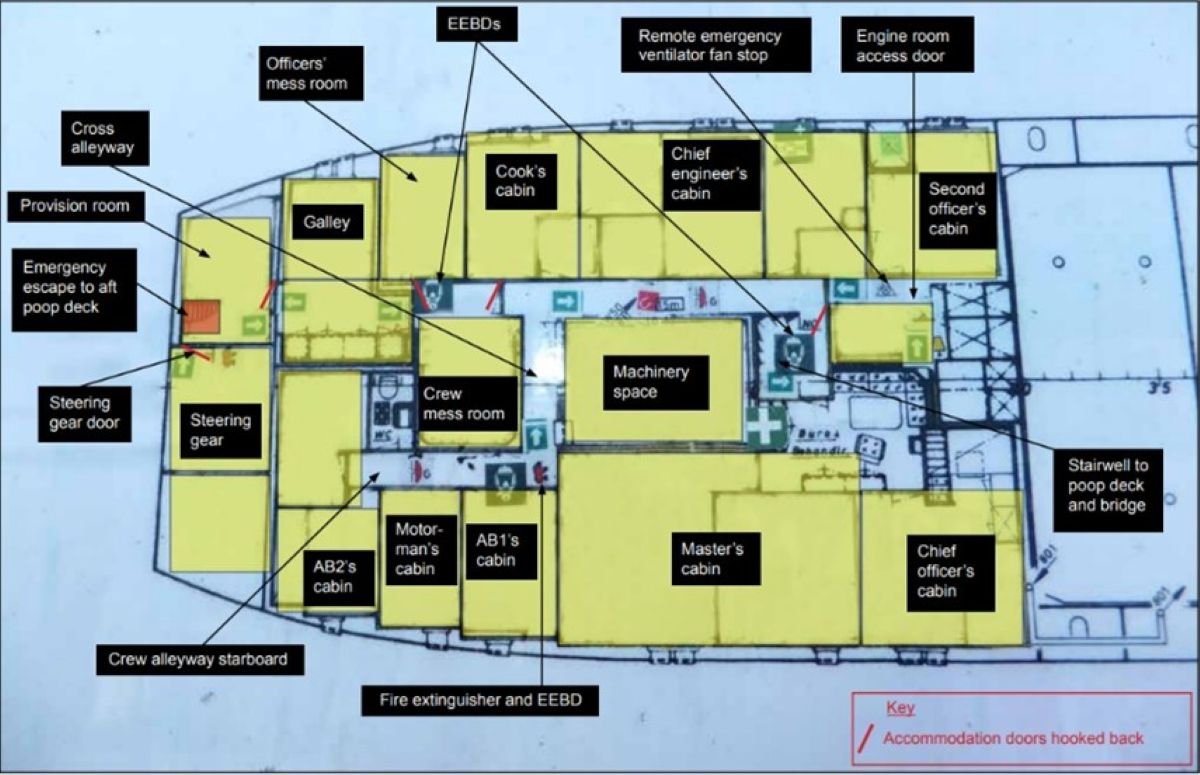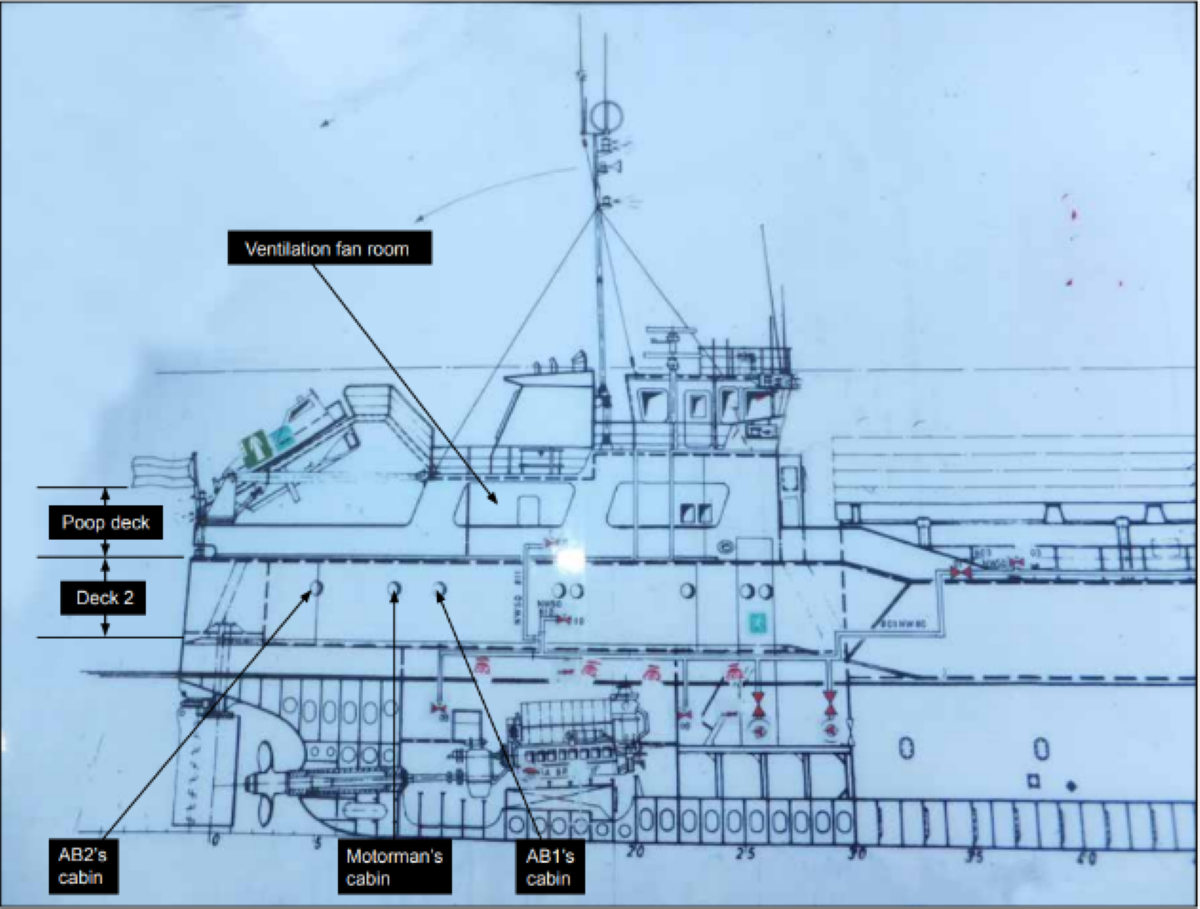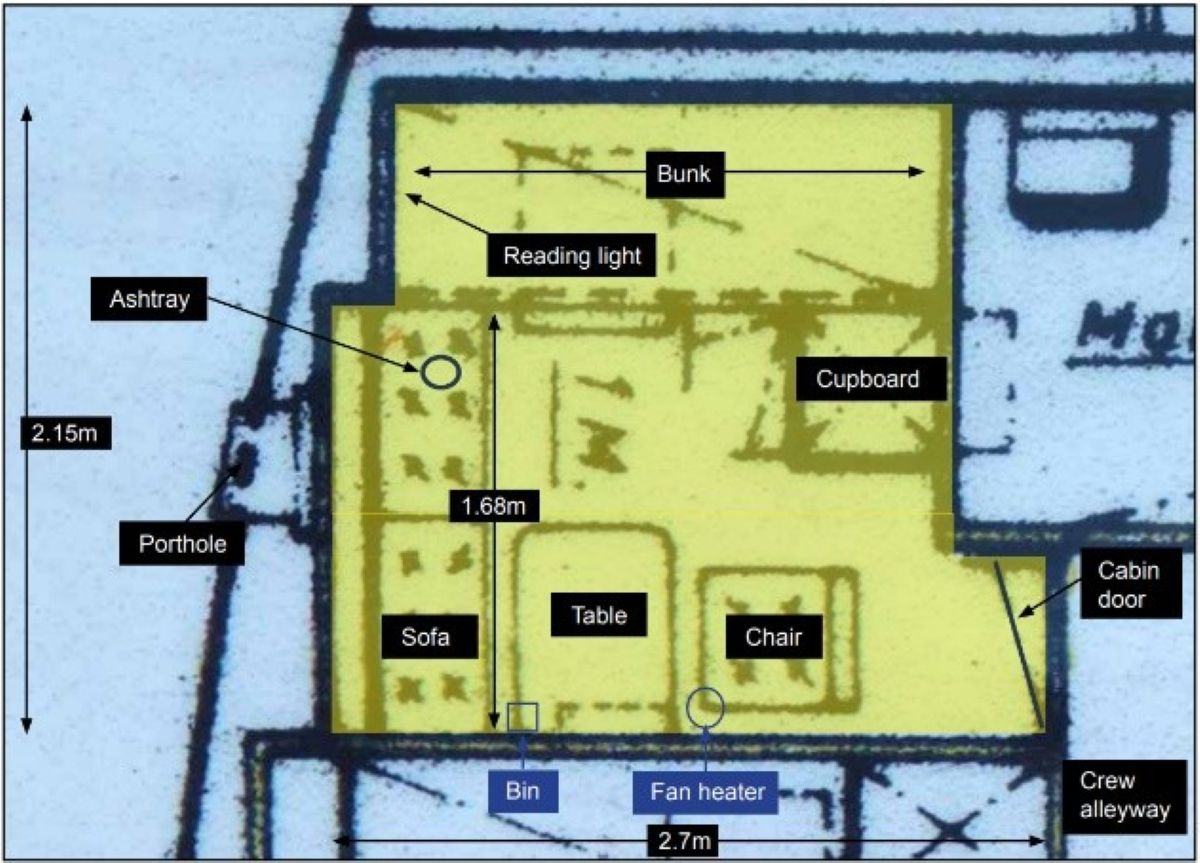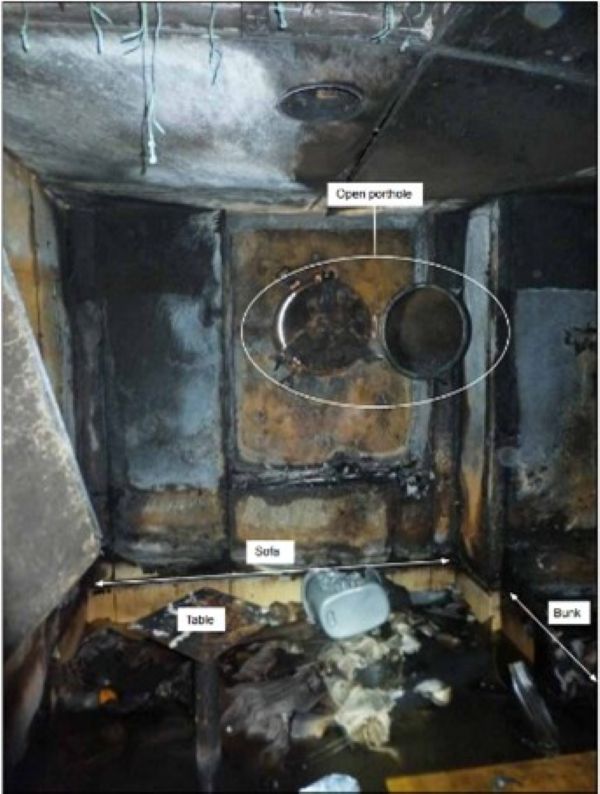A FIRE OCCURRED ONBOARD A 2,565 GT GENERAL CARGO SHIP, CAUSING EXTENSIVE DAMAGE AND INJURING ONE CREW MEMBER. FORTUNATELY, NO LIVES WERE LOST.

Source Ship Details (IHS Maritime, S&P Global)
WHAT HAPPENED
During a layover in Gibraltar for bunkering and minor repairs, the crew had the opportunity to go ashore. One of the crew members (AB2) consumed alcohol before returning to the ship, which then resumed its journey to Belfast. Later that evening, AB2 retired to his cabin located on the starboard aft side of Deck 2.

Source Marine Accident Investigation Branch – Gov.UK: Accident Investigation Report 18/2014
The crew member (AB2) opened the porthole in his cabin, a common practice onboard due to the ship’s unreliable and noisy ventilation system, which often drew dust into the cabins. He then spent some time drinking beer (approximately 6-8 units of alcohol) and smoking cigarettes, continuing these activities after getting into bed. It is presumed that a lit cigarette fell onto the adjacent sofa, which was made of highly flammable synthetic materials. A fire quickly spread in the confined, material-rich environment of the cabin. During the subsequent investigation, items such as papers, lighters, and a plastic container of paint thinner were reported to have been present.
At approximately 0315, the crew member awoke to pain in his right hand and leg, finding his cabin engulfed in smoke and flames. In a panicked and partially dressed state, he threw an already burning blanket from the sofa onto the fire and ran to the bridge to report a fire, failing to properly close the cabin door as he left. At approximately 0317, the ship’s second officer (2/O) proceeded to Deck 2 from the bridge to confirm the incident. After seeing smoke in the alleyway, he sounded the general alarm and initiated the muster protocol.
After mustering, the crew deployed three fire hoses and attempted to control the situation. The chief engineer (C/E) and motorman accessed the engine control room via an emergency hatch, shutting down certain systems (ventilation fans and electrical power to the accommodation) to prevent fire spread and started the fire/ballast pump and emergency generator. Other crew members closed ventilation dampers and prepared self-contained breathing apparatus (SCBA).
The 2/O and another crew member (AB1) wearing SCBA re-entered the accommodation area through the aft emergency escape hatch. They navigated through various compartments such as the provision room, galley, and crew mess room, under extremely hot conditions and poor visibility due to thick black smoke, continuously spraying water to manage the fire. Concerned about their remaining air supplies, they eventually withdrew just as their air ran out. A second attempt to enter was made by AB1 but it was cut short due to increasing temperatures.
With the chief officer’s (C/O) approval, the 2/O directed the crew to set up a stage along the starboard side of the ship near AB2’s cabin porthole. From here, AB1, equipped with various safety gear, managed to direct a fire hose into AB2’s cabin through the porthole. Whilst the master coordinated this from the bridge, receiving updates on the firefighting efforts, smoke and flames were seen from AB1’s cabin porthole. As the crew adjusted the stage along the starboard side, they observed a red glow and closed conditions in the motorman’s cabin. Due to intense heat from AB1’s cabin, multiple attempts were required to effectively aim the fire hose. Further concerns arose, around 0600 when the C/E noticed excessive water draining into the engine room, leading to the decision to stop the fire/ballast pump and postpone further inspections until daylight. Additionally, a power outage resulted in steering gear failure.
Shortly after 0800, as only vapour was observed from the cabin portholes, the master, C/O and C/E agreed that it was safe to re-enter the accommodation. They opened the poop deck door, fire dampers, and restarted the ventilation fans to assist the entry. The 2/O and AB1, equipped with SCBA, entered through the aft emergency escape hatch without a fire hose or extinguishers. With improved visibility and reduced temperature inside, they inspected the cabins: AB1 found his cabin partially damaged but still hot. AB1 checked the motorman’s cabin and noticed minimal fire damage but felt considerable heat from AB2’s cabin and returned to the deck.
By 0904, the master informed the shipowner about the cabin fire, water accumulation, and the unserviceable steering gear. The owner arranged tug assistance in response. However, the fire reignited in the motorman’s cabin less than an hour later, leading the crew to stop the ventilation and attempt to douse the fire through the porthole, unsuccessfully. The situation escalated, prompting an emergency call to the Maritime Rescue Co-ordination Centre (MRCC) by 1007. The MRCC then coordinated a response with nearby vessels.
Preparatory evacuation measures were taken by the crew. On deck, the life raft, immersion suits, search and rescue transponder (SART) and pyrotechnic flares were prepared. At 1025, the 2/O activated the ship’s Electronic Position Indicating Radio Beacon (EPIRB), though this was subsequently cancelled by the master at 1046.
By 1050, a naval ship had deployed fire teams to board and address the fire. Another merchant ship then arrived to provide support followed by a coastguard ship shortly afterwards.
By 1133, the navy teams were prepared to tackle the fire directly through planned entry points, while the merchant ship departed shortly afterwards. The fire was brought under control by 1226 and finally extinguished.

Source Marine Accident Investigation Branch – Gov.UK: Accident Investigation Report 18/2014

Source Marine Accident Investigation Branch – Gov.UK: Accident Investigation Report 18/2014

Source Marine Accident Investigation Branch – Gov.UK: Accident Investigation Report 18/2014

 English
English